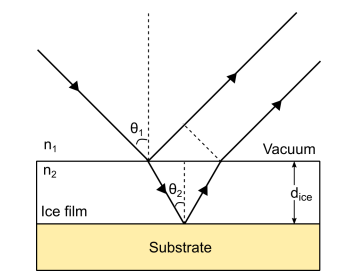Interferometry#
Ice thickness is determined by in-situ laser measurment (e.g. HeNe laser with a fixed wavelength of λ0 = 632.8 nm). The laser beam is positioned so that it reflects off the centre of the substrate and the reflected beam is measured with a photodiode
Note
- Include diagram of the setup
- position of the laser
- position of the detector

Fig. 1 Taken from Rachael, to redo#
Note
- add svg sin wave to show constructive, destructive interference
where \(y_0\) is the vertical offset, \(A\) is the amplitude, \(x_c\) is the horizontal offset and \(w\) is the period (i.e. \(2\pi/w\) is the frequency).
We define the sine function ‘sinfit(x, *p)’ for the fit with some initial guesses, which can be edited accordingly.
- A is obtained from the fit
Ice Refractive index#
Theory#
- Symbol: n
It is used to describe the optical properties of a pure medium and is a complex function of two parameters:
- k imaginary index - describe the attenuation or the absorbtion of the medium
- n real refractive index - it is the ratio of the velocity of light within the mediumwith respect to the speed of light in vacuum
Both k and n are wavelength dependant, hence require investigation over the whole electromagnetic spectrum:
- []: UV investigation (Amorphous and crystaline water ice)
Warning
- How does ice porosity affect the refractive index
- How has he been determined in the IR range.
- Should I use value of the litterature rather than the laser diode signal ?
Then we can estimate the refractive index of the ice (n2), can be estimated using the following equation
Using Snell’s Laaw (\(n_1 sinθ_1 = n_2 sinθ_2\))
Warning
Difference in fitting from different molecules
- single vs binary mixtures
To see how this is translated into code visit the folloing page []
